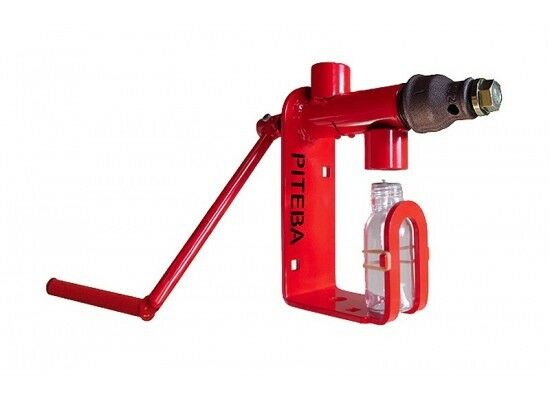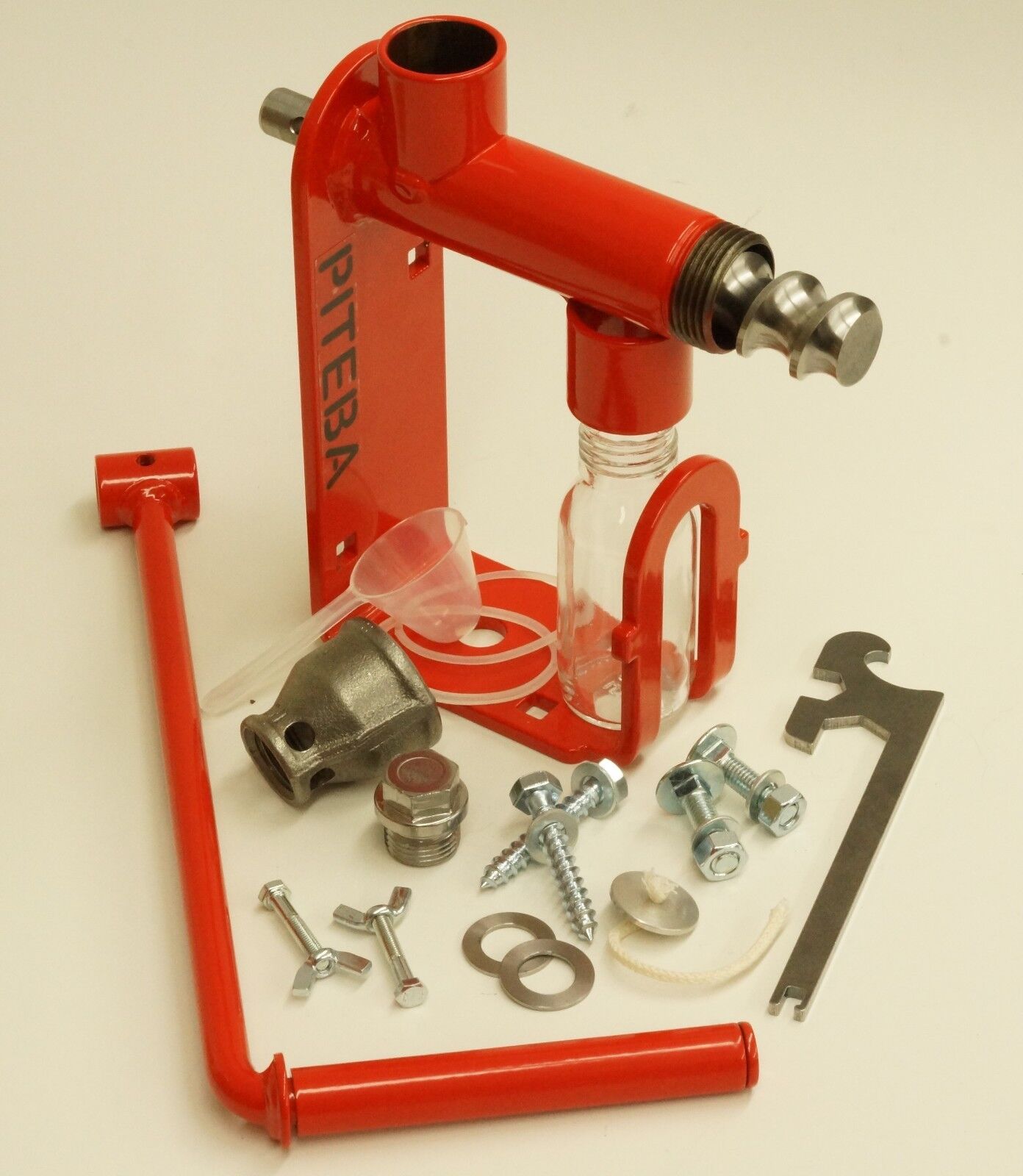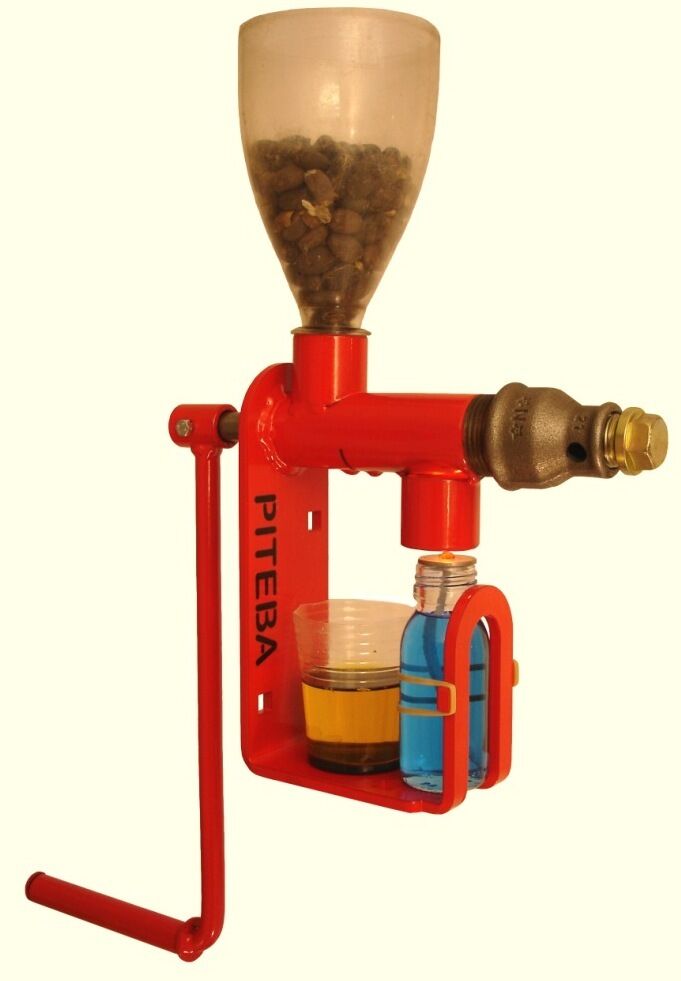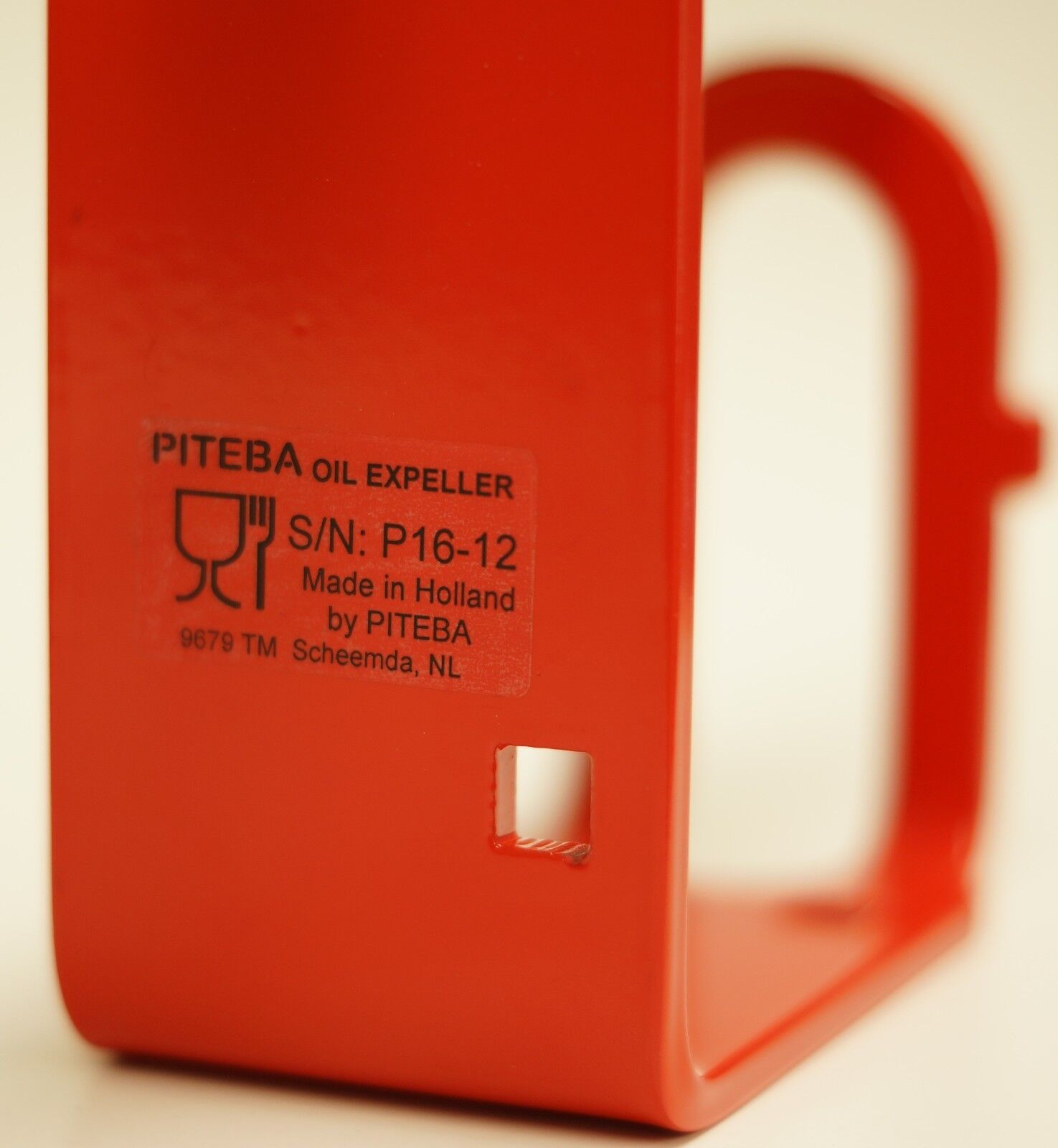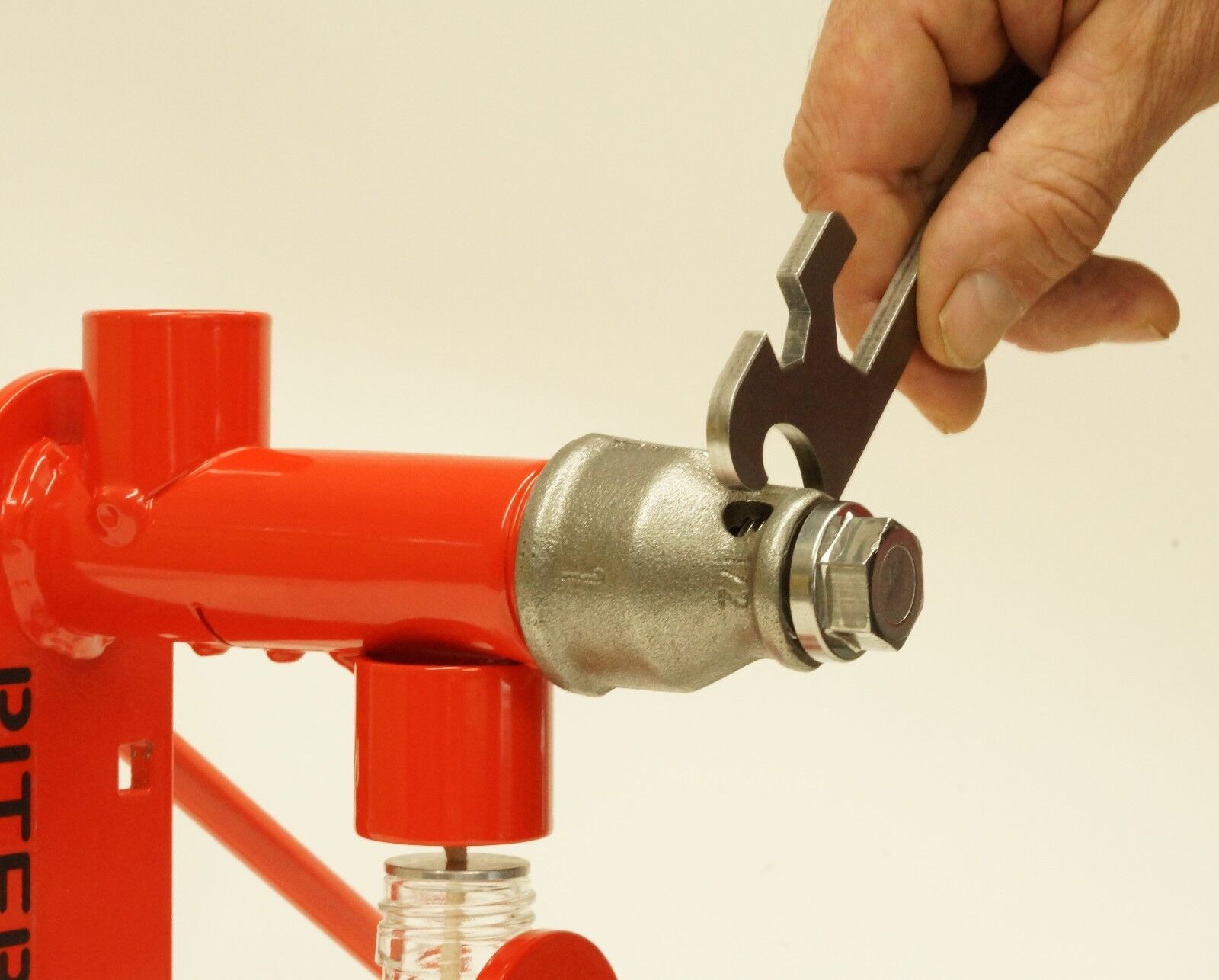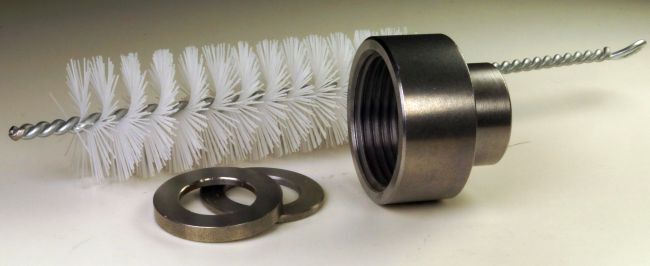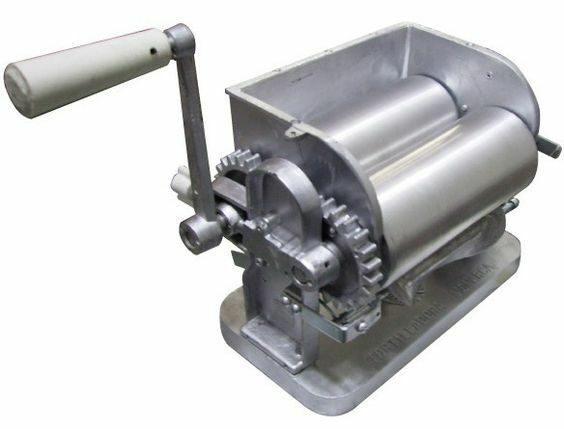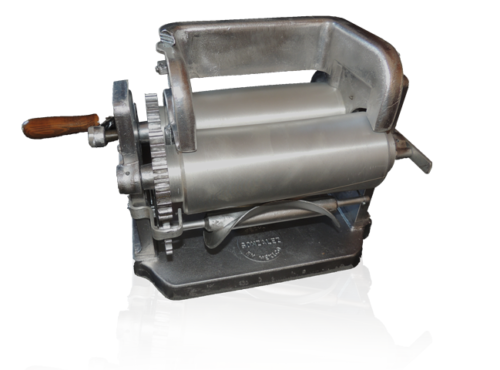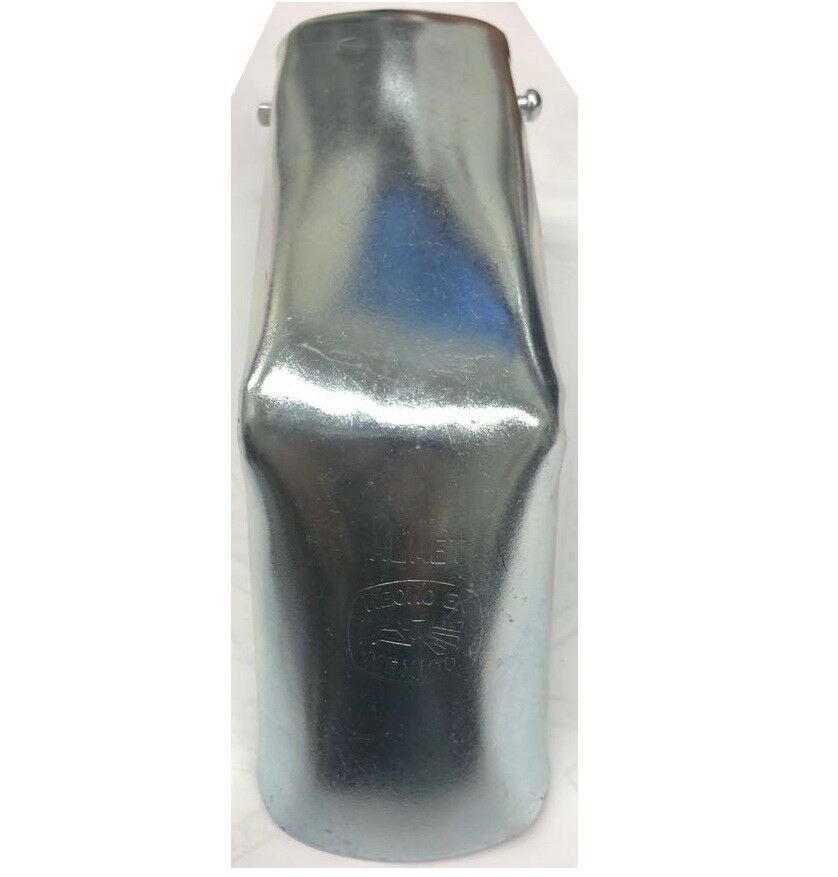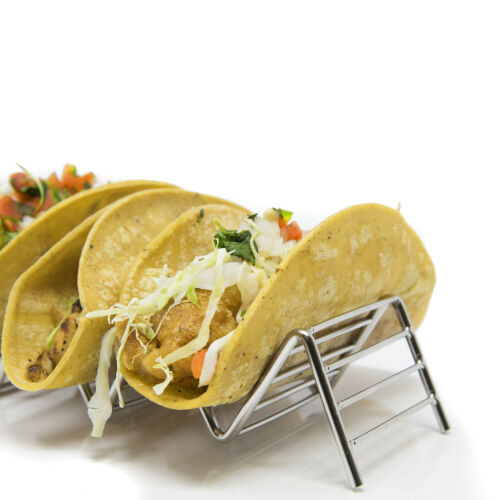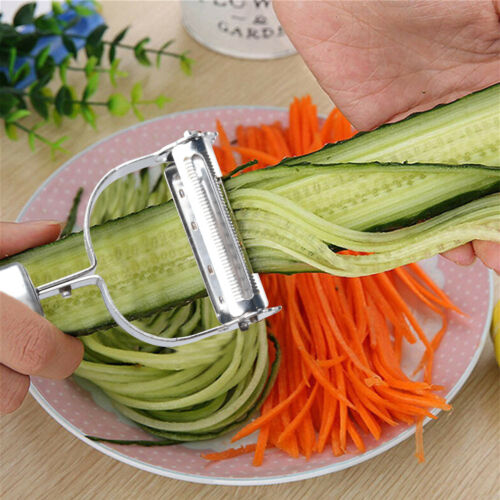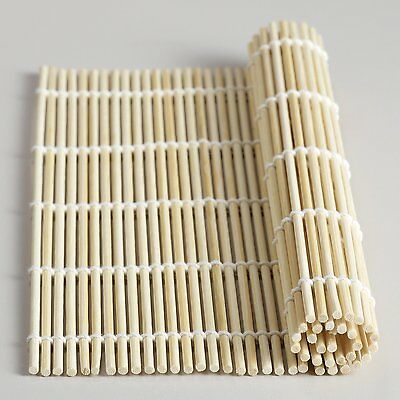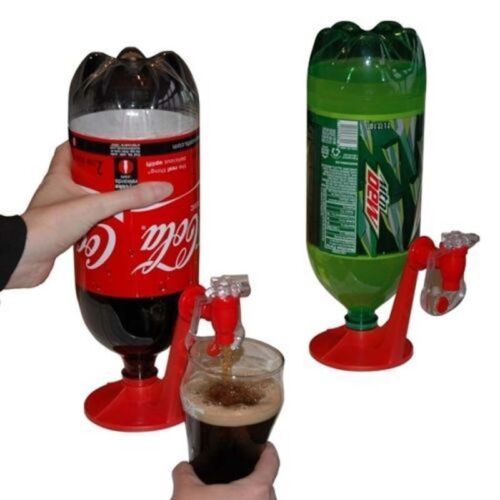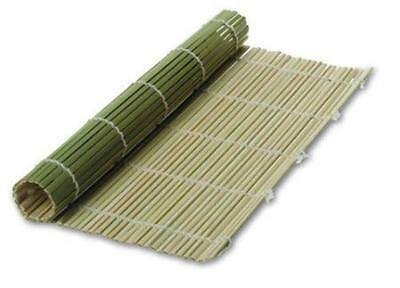-40%
Piteba Nut and Seed Oil Press and D2 Cap for Pressing Olive Oil with the Piteba
$ 96.09
- Description
- Size Guide
Description
The Piteba Oil Expeller is a low cost way to make your own high quality raw nut and seed oil at home. There are many videos showing its use on the internet, just search for Piteba. Suitable for almost all oil containing seeds with at least 25% oil in the seed. Will not work for grape seeds, or any stone fruit. The press does not come with the top hopper or a container to catch the oil. The hopper is made by cutting the top off a plastic pop or water bottle. The D2 cap transforms the Piteba oil expeller into a processing tool for fresh olives. With most olives you produce an excellent olive paste and from some varieties you even produce oil in 1 step. Piteba cannot advise you on the best olive varieties. It is up to you to test and see if the 1 step oil production method or olive paste production applies to your olives. Piteba hopes to get feedback from customers in order to inform others on the best varieties to use. How it’s done: OLIVE OIL Use fresh fully ripened oil olives. Fill the expeller with olives (including kernels) and push them into the screw with a stick while turning the crank. The olive press cake leaves the press and the oil comes through the oil slit. After settling, you have a clear olive oil. The exact procedure is explained in the manual that comes with the D-2 cap. OLIVE PASTE In case the olives cannot be pressed and produce oil in 1 step (to be determined for your olives in your experiment), you can use the D2 cap to crush the olives (including kernels) to produce a homogeneous fine structured olive paste. This paste is ready for malaxation and further processing with disks and a hydraulic piston press.PLEASE CHECK THE OLIVE YOU PLAN TO USE TO BE SURE THEY ARE OIL OLIVES ANDNOT THE LARGER TABLE OLIVES
. This press works and I cannot take returns stating it does not work as it is proven to work. You must follow the directions and have the correct olives. All returns will carry a restocking fee.
The Piteba Manual Nut and Seed Oil Press is the original design made in Holland with quality parts, and food safety in mind. The Piteba is still made by the small family owned company that came up with the original design. There is at least one illegal copy out there that is made in Asia where food
safety
, quality and employee treatment are of little concern. This is a great unit. Any concerns about its quality please check my feedback. I have sold 1000s of these over the last 5 years and only have very happy customers.
We've used our Piteba MANY times to press
macadamia
nuts and sesame seeds. It works great. We've sold some to friends of ours as well and they've successfully oiled hemp seeds, kukui nuts, coconuts and sunflower seeds. Its a great item for people who want fresh, raw nut and seed oils but don't want to pay the extremely high price for it. The Piteba would also be great for soap makers who want to make their own oils.
There are many videos on youtube showing it in use.
The press does not come with the top hopper or a container to catch the oil. The Piteba is made to to shipped anywhere in the world with low shipping costs. It comes with everything else pictured. The hopper is made by cutting the top off a plastic pop or water bottle. A small jar is used to catch the oil.
Item will be shipped via USPS Priority Mail medium flat rate box. We are only charging actuall shipping cost. If you would like insurance, please let me know so we can get you a price.
The Piteba must be mounted to a counter or work surface. You can also mount it to a board and then clamp the board to a counter using a woodworking clamp.
General Info:
Press uses a combination of heat and grinding to release oil from seeds and nuts
Will also make peanut butter and other nut butters (use roasted peanuts)
Completely non-electric
Produces healthy oils for cooking, making soaps, paints, and many other things
Press cake (what is left after oil is pressed) can be used in animal feed or as fertilizer
Press needs to be mounted--can be on a table, wall or the floor
Press up to 8 cups of oil per hour and process up to about 11 lbs of seeds per hour
Hand-made in Holland
8"H, handle is 11¼" L, weighs 4.75 lb
Will process oils from:
Almond
Babassu Kernel
Beechnut
Cocoa Bean
Coconut
Hazelnut
Hempseed
Jatropha
Linseed
Niger Seed
Oil Palm Kernel
Peanut
Pumpkin Seed
Rapeseed
Safflower
Sesame Seed
Soya Bean
Sunflower Seed
Walnut
MANY OTHERS not listed
Includes:
Oil press
Bottle for "lamp", wick and wick holder
1 elastic band (red) for securing the "lamp" to the press
Mounting hardware
Extra Supplies NOT included:
Funnel: use a plastic soft drink bottle--cut about 6" from the opening (OD of the outlet should be about 1¹⁄
8
")
Colored lamp oil (use colored so it is not confused with pressed oil)
2 containers: 1 to catch the oil and 1 the press cake
Tips:
Sift seeds and nuts through sieve to remove unwanted particles, stones, straw, etc.
Seeds and nuts should be well dried (8-10% moisture content)
No deshelling required (except for peanuts, walnuts and hazelnuts)
Make sure the washer on the end of the expeller screw is greased sufficiently with vegetable oil
Let sit about 10 min. after lighting and placing container under chimney so press cage is heated sufficiently
Depending on the type of seed or nut used, the adjustment bolt may or may not be used
Crank should be turned clockwise--speed of cranking is determined by what is being processed
Clean oil slit regularly to keep it from getting clogged
Clean unit immediately so press cake doesn't harden; if press cake can't be removed, soak in warm water
The press cake in the cap can also be softened before use (when already hardened) by heating the press before use for 30 min. Without removing the cake in the cap, you can start pressing (only if the same seeds or nuts are pressed). This will save a lot of cleaning time.
Oil should sit at room temperature for a few days so that the solids will settle--no filter is needed
Oil should be stored in a closed container in a cool, dark place until used
Operation
PITEBA oil expeller: suitable for almost all oil containing seeds with at least 25% oil in the seed
IMPORTANT FOR GOOD RESULTS
Moisture contents of the seed should be 8-10%
Too dry
(artificially dried seeds or dried in arid regions): press cake in cap is stone hard / no oil production
Too moist
: press cake flows back to the oil slit / no oil production
Properties of the PITEBA oil expeller:
High extraction efficiency
Continuous expelling
Manually operated (no external power source required)
Almost no maintenance required
Seeds can be expelled including seed coat
Simple operation
Compact Tool (2.2 kilo)
Quality Requirements of the Seeds:
Seed has to be well dried, but not too dry (8-10% moisture content)
No deshelling required except for groundnut, walnut and hazelnut
Seeds should be freed from any stones, sticks and sand before expelling
Big seeds such as walnut, hazelnut, oil palm kernel, coconut and babassu need reduction in size but should not be ground
Expelling Operation:
Before starting daily expelling: grease washer at the end of the shaft of the expeller screw with vegetable oil and insert the screw within the press cage
Mount press cage cap and terminal adjustment bolt--the use of the terminal adjustment bolt is indicated for every type of seed processed
IMPORTANT:
The thread of the press cage cap
has to be cleaned before turning the cap on the press cage.
If this is not done, the cast iron cap may burst!
The press cage should be heated for 10 minutes with the small oil burner, as provided, before starting work--the burner remains burning also during expelling
The expeller is operated by turning the crank clockwise
The seed enters through the funnel into the expeller screw--the screw moves the seed towards the press cage outlet; near the press cage outlet the seed is ground and exposed to a very high pressure
The oil is expelled near the press cage outlet and runs against the direction of the flow of the seed to the oil outlet--the oil needs time to move to the oil outlet
The press cake leaves the press cage at the end of the cap or the small holes depending on the use of the terminal adjustment bolt as indicated for each type of seed.
Oil outlet may be blocked by small particles and should be cleaned regularly with a blade to allow free oil flow
The oil is collected from the slit in the press cage and is collected in a container
The Oil:
Oil is collected in a container under the press cage and emptied in a big container
Impurities will settle in the big container after a few days--if necessary keep the oil at 30° Celsius (86° F) or slightly warmer to allow easy settling of impurities
Decant the clear oil--the oil is ready for use
The Press Cake
The press cake can serve as protein concentrate in feed for chicken, pigs, goats, ducks and cattle
The press cake can serve as organic fertilizer as it is rich in nitrogen, phosphorus, potash and magnesium
The press cake can serve as fuel
During Oil Expelling:
Check oil flow and clean with a blade the oil slit when the oil flow is impeded
After Expelling:
After expelling, remove the cap immediately from the end of the press cage when still hot
The hot press cake in the cap is still rather soft and easy to remove with a knife or a screw driver
Watch out!
Do not damage the thread inside the cap!
If the cap is not cleaned immediately when still hot, the press cake inside the cap becomes hard like stone and is difficult to remove
If you soak the cap in warm water for a few hours, the press cake will soften and can be removed
If the same type of seed is pressed again and the press cake is cooled down and stone hard
: light the small burner and wait for 20-30 minutes--the press cake will turn plastic again and you can continue pressing without removing the press cake
After expelling the press cage is cleaned by putting some seed into the funnel and turning the crank--do not use the adjustment bolt so the seed will flow freely cleaning the cap
Grease the washer at the end of the shaft of the expeller screw with a few drops of vegetable oil
Seed Performance
Performance of the PITEBA OIL EXPELLER with various oil seeds
Type of Seed
% Total Oil to Seed
% Oil Extraction
% Extraction Efficiency
Grams Oil/Hr
Liters Oil/Hr
Kg Seed/Hr
Remarks
Almond
Prunus dulcis
65
58
89
1249
1.40
2.2
Grated
Babassu
Orbignya phalerata
72.7
62
85
1227
1.36
2.0
Crushed
Beechnuts
Fagus sylvatica
37.7
29
77
501
0.56
1.7
Crushed
Cocoa Beans
(undecorticated)
Theobroma cacao
56.8
37
65
1158
1.286
2.5
Grated
Coconut (Coprah)
Oil
Cocos nucifera
68
59
87
1839
2.04
3.11
Grated
Coconut (Coprah)
Cream
Cocos nucifera
45
87
1367
1.3
Press cake can be dried and oil can be pressed
Hazelnut
Corylus avellana
68
55
81
1325
1.47
2.4
50 rpm
Hemp Seed
Cannabis sativa subsp. sativa
34
23
68
1095
1.21
4.8
Jatropha
(decorticated)
Jatropha curcas
70
54
77
1408
1.56
2.0
Jatropha
(undecorticated)
Jatropha curcas
41.7
32
77
533
0.581
1.6
Linseed/Flaxseed
Linum usitatissimum
40
34
85
1855
2.06
5.4
Niger Seed/Noog
Guizotia abyssinica
43
36
84
1490
1.66
4.1
Oil Palm Kernel
Elaesis guineensis
68
46
68
1280
1.342
2.8
Not crushed
Peanut
(Shelled Groundnut)
Arachis hypogaea
57
40
7
1468
1.65
3.61
Pumpkin Seed
Cucurbita sp.
45.5
39
86
570
0.63
1.5
Low input
Rapeseed/Canola
44
33
75
1524
1.69
4.5
50 rpm
Safflower
Carthamus tinctorius
26.6
22
78
1100
1.22
5.0
55 rpm
Sesame
Sesamum indicum
60.4
46
77
1738
1.93
3.8
50 rpm
Soya Bean
67
Sunflower
(black oil seed)
Helianthus annuus
45
34-38
76-84
1200
1.33
3.4-3.6
Sunflower
(striped, non oil)
21.6
415
.471
Use black oil seed
Walnut
(kernel + partition)
Juglans sp.
71
63
89
894
1.00
1.4
grated
Processing Details
Important for a good result: the seed should be well dried (8% humidity)! In case the press cake is squeezed through the oil slit: the seed is not dry enough. Seed Expelling Instructions (rpm=rounds per minute)
Type of Seed
Expelling Properties
Remarks
Almond
Well dried, whole almonds with seed coat are expelled. Bridge formation may occur in the funnel. It might be easier to feed the expeller without a funnel. Turn crank at 55-60 rpm.
use terminal adjustment bolt with openings fully open - after press cake appears, the bolt can be tightened to obtain high extraction efficiency
clean oil outlet regularly
turning requires reasonable force
Babassu
(Orbignya phalerata)
The kernels need to be reduced in size by grating, pounding or chipping. Turn crank at 45-50 rpm to allow oil to flow to the oil outlet.
expel without adjustment bolt
turning goes lightly
Beechnut
(Fagus sylvatica)
Well dried seed with 8% moisture or less should be expelled including the seed coat. Remove first any sand, stone and twigs. Bridge formation may occur in the funnel. Use a small wooden stick to ease flow of seed. Turn at 50-60 rpm.
expel with adjustment bolt leaving the 2 press cake outlets open; later on tighten bolt until press cake appears as 2 thin strings
turning requires reasonable force
Cocoa Bean
Whole beans can be processed, including skin. Flaked beans will be easier to fill which will increase yield. Oil clarifies after about 24 hours at 50° C and will solidify after cooling. Turn crank at 50 rpm.
first stop outflow of seeds with finger before press cake outlet until stiff roll appears
start with open terminal adjustment bolt--once press cake comes out of 2 openings bolt can be tightened
turning requires reasonable force
Coconut
(coprah)
Well dried coprah is reduced in size by cutting, grating or grinding. Feeding the expeller requires some skill due to bridge formation. To avoid oil clogging of the screw turn calmly at 45 rpm to allow oil to flow to the oil slit.
do not use the adjustment bolt--stop the outflow of press cake lightly with a finger until a dry press cake appears
turning goes fairly lightly
Hazelnut
Remove (deshell) the nuts. To increase output per hour reduce the size of the kernels (seeds) by coarsely grinding or grating. Turn at 50 rpm.
expel with adjustment bolt and gradually tighten the bolt until press cake appears in thin strings
turning goes easily
Hemp Seed
(Cannabis)
The seed runs easily into the press cage. Turn at 45 rpm.
do not use the adjustment bolt
turning requires considerable force
Jatropha
(physic nut or Jatropha curcas)
The seeds should be removed from the capsules. The whole seed should be expelled. Remove any stones and sand by sifting. Avoid bridge formation in the funnel by using a small wooden stick. Turn at 50 rpm.
do not use adjustment bolt
turning of crank requires considerable force
Linseed
The seed runs easily into the press cage. Turn at 45-50 rpm to allow the oil to flow to the oil slit. Clean the oil slit regularly.
expel with adjustment bolt leaving the 2 press cake exits fully open
turning requires considerable force
Niger Seed
The seed runs easily into the press cage. Turn at 45-50 rpm to allow the oil to flow to the oil slit. Clean oil slit regularly.
do not use the adjustment bolt
stop seed with a finger from press cake outlet until dry press cake appears
turning requires considerable force
Oil Palm Kernel
The kernels are very hard. The kernels are first reduced in size in a
hammer mill as used for maize
. Prevent bridge formation in the funnel with a small wooden stick. Keep the oil warm to allow settling of dirt before decanting.
expel with adjustment bolt with open press cake outlets
turning requires considerable force
if turning is difficult remove adjustment bolt and continue expelling
Peanut
(groundnut, unroasted and deshelled)
Well dried groundnuts are expelled with the thin brown seed coat. Prevent bridge formation of the seed in the funnel. Remove any stones and gravel. Clean oil slit regularly. Turn at 45 rpm.
at first adjustment bolt with open press cake exits, then tighten bolt until 2 thin strings of press cake appear
turning goes fairly lightly
Lehman's tested: for peanut butter, don't use lamp
Pumpkin Seed
Expel with the seed coat. Remove stones and gravel to avoid damage to the expeller screw. Seeds enter slowly into expeller leading to a relatively low oil yield per hour. Turn at 55 rpm.
do not use adjustment bolt
turning requires considerable force
Lehman's tested: oil temp reached about 107°F
Rapeseed
First remove any sand with a fine sieve and straw with a coarse sieve. Seed has to be very well dried until 6-8% moisture content. Extraction efficiency is highly reduced above 8% moisture content. Turn at 45 rpm to allow oil to flow to the oil slit.
expel with adjustment bolt
first keep 2 press cake outlets open; afterwards tighten bolt until 2 thin strings of press cake appear
turning goes quite easily
Safflower
Seed should be expelled with its seed coat. Remove any stones and gravel. Prevent bridge formation of the seed in the funnel with a small wooden stick. Turn at 45-50 rpm.
expel without adjustment bolt
allow press cake formation by keeping initially a finger in front of the outlet
turning requires considerable force
Sesame Seed
(sim sim)
The seed must be dry with only 4-5% moisture content. Turn the crank slowly at 45 rpm to allow oil flow to the oil slit. Clean oil slit regularly.
adjustment bolt at first with open press cake exits, then tighten bolt until 1 thin strings of press cake appear
turning requires some force
Lehman's tested: oil temp reached about 80°F
Soya Bean
Take care and remove any sand, stones and straw before expelling. Seeds flow easily in the expeller. Beans should be preheated in a pan before expelling. Turn crank at about 50 rpm.
First stop outflow of seeds with a finger before press cake outlet until a stiff roll of press cake appears
Turning requires reasonable force
Sunflower Seed
The whole seed (undecorticated) should be expelled. Take care to remove any stones before expelling; prevent bridge formation in the funnel with a small wooden stick. Turn at 60 rpm.
expel without adjustment bolt
turning requires fair force
Walnut
Remove the shell. Grind kernels coarsely including the partition skin between the 2 halves. Turn at 55-60 rpm.
adjustment bolt at first with open press cake exits, then tighten bolt until 2 thin strings of press cake appear
turning goes lightly
